How do composers write music? To what extent can we explain their thought processes? Ever since Nottebohm's pioneering excavations of Beethoven's sketchbooks, musicologists and theorists have tried to find answers in composers' sketches and drafts. Psychologists, too, have recognized the significance of these workings. As John Sloboda points out:
Sketches and notebooks, if datable, can show how a composition grew and changed over the time during which it exercized the composer's mind . . . . Even where sketches do not exist we can sometimes discover something about the compositional sequence from the final manuscript.1
Sloboda has, in fact, combined studies of sketches, verbal testimonies, eyewitness accounts, and even live observations of contemporary composers, to reconstruct the creative methods of Beethoven, Stravinsky, and Mozart.2
But while there can be little doubt that composers' sketches and drafts have tremendous value, it is less clear how they should be interpreted. On the contrary, when we try to use them, we soon run into a wide range of difficulties that actually cut across accepted boundaries between historical musicology, music theory, and cognitive psychology. These issues are of four main types. First, as Sloboda and others have stressed, there are difficulties locating, identifying, transcribing, dating, and ordering the workings per se.3 To begin with, it is by no means easy to find all of the extant revisions for any piece. Not only must we track down each document in libraries and private collections, but we also must assume that only a fraction of a composer's workings will ever have survived. Unfortunately, we can never know how much of the material has been lost, or how much of the composer's thinking was never written down. Identifying and transcribing revisions can be equally traumatic. Because sketches and drafts are aides memoires for the composer's private use, they are often untidy and filled with abbreviations of one sort or another. To make matters worse, ideas for one piece may be jumbled up with those for another, or with material that was eventually discarded entirely. We encounter further stumbling blocks in trying to date and order each working. When the material is dated, we may not be sure what the date refers to; when it is undated, we may be forced to rely on correspondence, eyewitness accounts, and so forth to establish their chronologies. Sometimes we can guess at the order of composition by classifying each source; however, the distinctions between sketches, drafts, and autographs are fluid at best and are not perfect guides to their histories.4
Second, even if we assemble all of the extant workings for a given piece, we must always interpret them in light of the composers' general musical environment. Composers normally develop distinctive working habits and intentional goals; these are shaped by their education, listening preferences, contact with other artists, and so forth. They also write for particular functions, genres, media, and styles. The problems here are two-fold. On the one hand, composers' motives are notoriously difficult to determine; they may be vague or ambiguous and may alter as the work evolves. Some pieces have conflicting or unfulfilled goals and produce effects that are consciously unintended.5 Sometimes composers may not be aware of their real motivations or accurate in reporting them to others. To quote Leonard B. Meyer, composers "are no more reliable witnesses to their own motives—the basis for their choices—than are any other protagonists of history."6 On the other hand, it is not easy to establish causal connections between composers' actions and their external environments. Obviously, not all the events or objects that composers encounter have a direct bearing on their musical decisions. Composers filter their experiences—they select, abstract, and elaborate them in numerous complex ways. To decide what knowledge is relevant, we must be able to explain how this filtering takes place.7 This issue is psychological rather than historical in nature.
Third, even if we isolate the relevant intentional and historical constraints, our reconstruction of a composer's methods will always be shaped by our own analytical interpretations of the finished score. To quote Meyer again:
the changes made by composers from sketches to draft to finished work can be understood and explained only in the light of some theoretical-critical viewpoint. To discover and classify the compositional stages followed and changes made by Bach or Beethoven is to describe their compositional procedures, not to explain their compositional thinking. We can explain why a composer changed the passage as he did . . . only if we have a theory about the nature of musical relationships.8
The fact is that composers' workings are seldom framed as analytical statements; their musical significance will always be inferred post facto by us and will therefore reflect our own theoretical assumptions and predispositions.
Fourth, the question of how composers create must eventually turn to the human mind, because it is here that this act really takes place. The snag is that, from a cognitive perspective, composition remains "the least studied and least well understood of all musical processes."9 Certainly researchers face many hurdles when they try to study composition experimentally. For one thing, composing is clearly an extremely complex activity; it is hard to isolate one variable from another. For another, our understanding of composition is limited by the fact that we still know very little about the general ways in which people perceive, encode, store, and recall music.
Nevertheless, despite these gaps in our knowledge, there is strong evidence that certain aspects of musical composition can be understood in more general cognitive terms. For example, cognitive psychologists often discriminate between bottom-up (or data-driven) and top-down (or concept-driven) thinking: the former is guided by the individual items of data coming in from the outside world, the latter by hierarchically organized knowledge structures (or schemas) already learned from past experiences. Experts seem to agree that when performing complex tasks, the brain apparently shifts seamlessly between bottom-up and top-down procedures.10 Musical composition is a good case in point. For example, when describing the processes governing composition, Sloboda highlights two basic features:
One is the persistent occurrence of superordinate structures or plans which seem to guide and determine note-by-note working out. The other is the degree to which these plans can . . . be rather provisional . . . [and] can be changed in the light of the way a particular passage "turns out."11
He suggests that this fluid interchange between top-down and bottom-up working explains why composers only consider a few alternative solutions to particular musical problems, why they continually refine local and global aspects of their work, and why they can work on different parts of the piece at one time. Sloboda also notes that these ideas fit nicely with theoretical models such as Schenkerian theory in which tonal relationships are explained across different levels. In fact, we can think of Schenkerian graphs as our own mental reconstructions of the ways in which tonal composers organize their knowledge of tonality.12 This knowledge, which can be expressed informally as the rules of harmony and counterpoint, is represented schematically as a set of basic tonal states (or Ursätze), transformations (or Verwandlungen), transformational rules, and levels (or Schichten).13 In this case, the Ursätze and transformational rules account for the fundamental elements common to all continuous monotonal pieces, whereas the transformations and levels account for the extraordinary diversity that we find within the tonal repertory. Of course, by explaining tonal relationships at different levels, Schenkerian theory allows us to explain tonality in a bottom-up as well as a top-down sense.
How does this information help us understand the genesis of a specific piece? We will now answer this question by looking at Par les rues et les chemins, the first movement of Debussy's Ibéria.14 Let us begin by considering the thematic/tonal layout of the finished score and then look at Debussy's sketches and drafts for the movement.
Like Fêtes and many of Debussy's other orchestral works, Par les rues et les chemins, is a modified ternary form.15 Very briefly, it contains an opening A section in G major (mm. 1-177); a B section in  major (mm. 178-233); a retransition (mm. 234-71); an abridged version of the A material in the home key (mm. 272-312); and a short coda (mm. 313-34). Figure 1 lists four of the main themes. Figure 1a gives the opening melody with its accompanying rhythm. Besides having the melodic inflections and rhythmic profile we expect from a sevillana, this theme has a very distinctive overall shape; it begins by elaborating
major (mm. 178-233); a retransition (mm. 234-71); an abridged version of the A material in the home key (mm. 272-312); and a short coda (mm. 313-34). Figure 1 lists four of the main themes. Figure 1a gives the opening melody with its accompanying rhythm. Besides having the melodic inflections and rhythmic profile we expect from a sevillana, this theme has a very distinctive overall shape; it begins by elaborating  with the upper neighbor
with the upper neighbor  , and then descends by step to
, and then descends by step to  .16 Later on in the piece, Debussy truncates the theme by omitting the final descent. The basic shape of the complete main theme can also be seen in Figure 1b, one of the subordinate themes from the opening A section. As before, the main pitch is ornamented by an upper neighbor and followed by a stepwise descent. The version given in Figure 1b is a chromatic transformation of Figure 1a: this time Debussy lowers
.16 Later on in the piece, Debussy truncates the theme by omitting the final descent. The basic shape of the complete main theme can also be seen in Figure 1b, one of the subordinate themes from the opening A section. As before, the main pitch is ornamented by an upper neighbor and followed by a stepwise descent. The version given in Figure 1b is a chromatic transformation of Figure 1a: this time Debussy lowers  ,
,  and
and  . Another related gesture from the opening A section is shown in Figure 1c. As before, we see an upper neighbor motion followed by a stepwise descent. Finally, Figure 1d shows the
. Another related gesture from the opening A section is shown in Figure 1c. As before, we see an upper neighbor motion followed by a stepwise descent. Finally, Figure 1d shows the  major motive that dominates the B section and the retransition. The rhythmic and tonal profile of this gesture are obviously quite different from Figures 1a-c.
major motive that dominates the B section and the retransition. The rhythmic and tonal profile of this gesture are obviously quite different from Figures 1a-c.
Figure 1. Main themes from Par les rues at les chemins
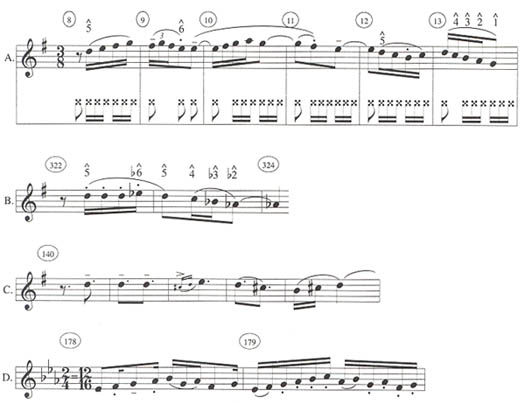
Figure 2 summarizes the tonal layout of Par les rues et les chemins: Figure 2a graphs the final A' section (mm. 272-312), Figure 2b the coda (mm. 313-34), and Figure 2c the entire piece. When we compare these different analyses, two things stand out: 1) each section uses chromatic variants of the same basic patterns; and 2) the upper line of this pattern matches the shapes in Figures 1a-c. For example, in the final A section Fire 2a), Debussy projects the upper line  -
- -
- -
- -
- -
- -
- and fills out the motion from
and fills out the motion from  -
- with a chromatic descent in the inner parts. This descent starts with G-D-B and then moves down from F-C-A, to
with a chromatic descent in the inner parts. This descent starts with G-D-B and then moves down from F-C-A, to  -
- -G, and so forth to
-G, and so forth to  -
- -G. Debussy then reworks this pattern in the coda (Figure 2b). The upper line presents the chromatic variant of Figure 2a—
-G. Debussy then reworks this pattern in the coda (Figure 2b). The upper line presents the chromatic variant of Figure 2a— -
- -
- -
- -
- -
- -
- —while the motion from
—while the motion from  and
and  is expanded by a slightly different chain of chromatic inner parts. Finally, Figure 2c shows that a similar scheme controls the underlying counterpoint of the entire piece. Here, we see that the opening A section expands the motion
is expanded by a slightly different chain of chromatic inner parts. Finally, Figure 2c shows that a similar scheme controls the underlying counterpoint of the entire piece. Here, we see that the opening A section expands the motion  -
- with descending lines analogous to those in Figures 2a and 2b. Debussy even marks the main points of articulation—mm. 94, 106 and 122—with truncated versions of the sevillana tune. Notice, too, how the upper line alternates between raised
with descending lines analogous to those in Figures 2a and 2b. Debussy even marks the main points of articulation—mm. 94, 106 and 122—with truncated versions of the sevillana tune. Notice, too, how the upper line alternates between raised  (m. 90) and lowered
(m. 90) and lowered  (m. 178); this modal shift is anticipated in Figures 1a and 1b. All in all, Par les rues et les chemins shows a close relationship between local and global organization; the same patterns govern the layout of themes and tonal spans. While such relationships are seldom associated with Debussy's music—Richard Parks recently claimed that "in Debussy, linear progressions tend to be of the simplest sort and of only local significance"—tonal models of this sort are quite common in his symphonic works.17
(m. 178); this modal shift is anticipated in Figures 1a and 1b. All in all, Par les rues et les chemins shows a close relationship between local and global organization; the same patterns govern the layout of themes and tonal spans. While such relationships are seldom associated with Debussy's music—Richard Parks recently claimed that "in Debussy, linear progressions tend to be of the simplest sort and of only local significance"—tonal models of this sort are quite common in his symphonic works.17
Figure 2. Tonal models in Par les rues et les chemins
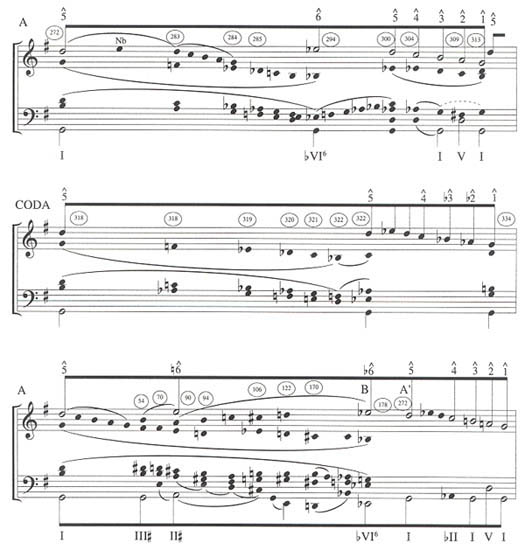
Our next task is to see how Debussy actually set about creating this subtle balance between bottom-up and top-down processes. Figure 3 catalogs the known sources for Par les rues et les chemins and their approximate chronology.18 Debussy originally conceived the set in the spring of 1905. On May 16, he announced to Durand that he was writing three Images for two pianos to be entitled Gigues tristes, Ibéria and Valse.19 Sometime in 1906 he replaced Valse with Rondes de printemps and recast the set for orchestra.20 The earliest extant sketches probably come from early the next year; over the next eighteen months Debussy worked on all of the movements and left extensive sketches and intermediate drafts for Par les rues et les chemins. Debussy finished the orchestral draft for Ibéria in the fall of 1908 and copied the autograph in the spring of 1909.21 Several months later, he corrected proofs; Durand published the finished score in April 1910, just a few weeks after its premiere.22
Figure 3. Main sources for Ibéria
Sketches and preliminary drafts: Images sketchbook——US-NYpm, Lehman Deposit (ca. 1906-9) F-Pn Ms. 21005 (ca 1906-8) F-Pn Ms. 10931 (ca 1907-8) F-Pn Ms. 14518 (before 24 December 1908) Final orchestral draft: Mvt. 1 not located US-NYpm, Lehman Deposit, Mvt. 2-3 (25 December 1908) Autograph: F-Pn Ms. 1009 (spring 1909) First Edition: Durand Pl. no. 7576 (April 1910) Corrected score: F-ASO, coll. François Lang Piano Reductions: Piano à 4 by Caplet, Durand, Pl. no. 7705 (June 1910) 2 Pianos à 4 by Caplet, Durand, Pl. no. 7706 (June 1910)
Although the list of sources is quite extensive, some documents are at present missing; researchers have not yet recovered the orchestral draft for Par les rues et les chemins or any of Debussy's corrected proofs. We can also assume that much of the composition was never written down; we know that Debussy tended to let pieces simmer in his mind before he started writing and that he often improvised extensively.23 There is also evidence that he performed nascent pieces to his friends from sketches and drafts; in a letter of 8 March 1908 Debussy promised to play Durand "a large part" of the Images.24
The oldest extant workings for Par les rues et les chemins appear on pp. 6-7 of the Images sketchbook. As shown in Figure 4, Debussy wrote two statements of the sevillana theme and a single statement of the  major theme. Both versions of the sevillana theme contain the pickup to G, the distinctive upper neighbor motion D-E-D, and the ubiquitous triplet turn. Like the final tune, these sketches employ superimposed triple and duple groupings; whereas the accompaniments both establish triple meter, the tunes are clearly notated in duple. In the case of the
major theme. Both versions of the sevillana theme contain the pickup to G, the distinctive upper neighbor motion D-E-D, and the ubiquitous triplet turn. Like the final tune, these sketches employ superimposed triple and duple groupings; whereas the accompaniments both establish triple meter, the tunes are clearly notated in duple. In the case of the  major theme, Debussy's sketch is particularly advanced: it clearly contains the internal repetition and the shift from dotted to triplet note values.
major theme, Debussy's sketch is particularly advanced: it clearly contains the internal repetition and the shift from dotted to triplet note values.
Figure 4. Debussy, Par les rues et les chemins, US-NYpm, Lehman Deposit, Images sketchbook, pp. 6-7.
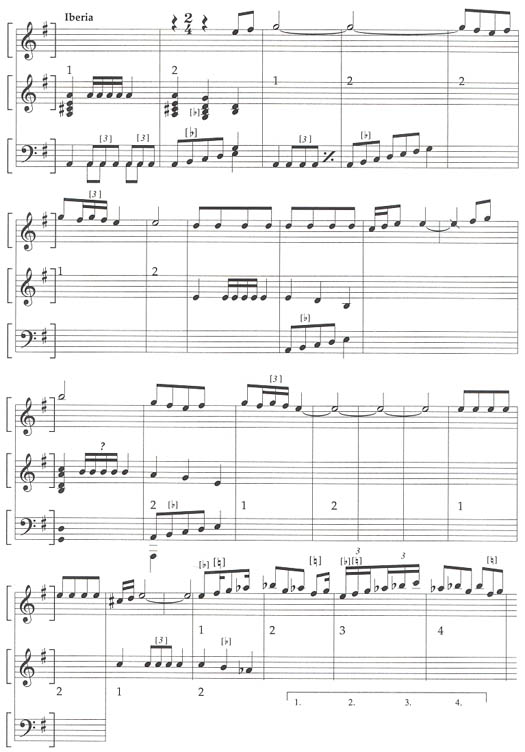
Despite these similarities, the early sketches do diverge from the finished score in several regards. To begin with, the sevillana theme lacks the final descent from D to G. In this regard, it looks more like the truncated version than the complete theme. Similarly, although both statements exploit the contrast between duple and triple groupings, they are a good deal simpler than the final theme. Equally interesting are the differences between Debussy's two harmonizations: the final sevillana theme is harmonized with a tonic pedal in G and stacked fifths, whereas the original version is in A and includes a rising bass motive. Figure 4 also shows that the original sevillana theme contained allusions to the gesture given as Figure 1c, and that the second statement led directly to what was to become the  major theme (Figure 1d). Indeed, Debussy not only wrote the two tunes consecutively, but he even notated them in 2/4. In the final score the
major theme (Figure 1d). Indeed, Debussy not only wrote the two tunes consecutively, but he even notated them in 2/4. In the final score the  major theme appears in 12/16.
major theme appears in 12/16.
Debussy continued to tinker with the original sevillana tune on fol. 2r of F-Pn Ms. 21005. To some extent, this version clarifies the earlier sketch; Debussy not only wrote the melody in 2/4 and the accompaniment in 3/4, but he also added important details, such as the appoggiatura  -
- . The sevillana theme, however, still lacks the rising fourth of the pickup, the internal sequence, the final descent from D to G, and it is harmonized in A rather than G. Although the sketches on fol. 2r hint at Figure 1c, it is unclear whether this material is still attached to the B theme. However, on p. 32 of the Images sketchbook Debussy had taken this crucial step. This sketch gives the truncated theme almost exactly; Debussy includes the pickup from D to G, the turn figure, and the repetition of this material on E. The tune is notated in 3/8 and, given the abbreviation "Sol.," is clearly in G major.
. The sevillana theme, however, still lacks the rising fourth of the pickup, the internal sequence, the final descent from D to G, and it is harmonized in A rather than G. Although the sketches on fol. 2r hint at Figure 1c, it is unclear whether this material is still attached to the B theme. However, on p. 32 of the Images sketchbook Debussy had taken this crucial step. This sketch gives the truncated theme almost exactly; Debussy includes the pickup from D to G, the turn figure, and the repetition of this material on E. The tune is notated in 3/8 and, given the abbreviation "Sol.," is clearly in G major.
Once Debussy had devised the truncated version of the sevillana theme, he worked it out in short score on fol. 4r of F-Pn Ms. 21005. Figure 5a shows that the new accompaniment is transposed to G and conforms quite closely to that of the final score.
Figure 5a. Debussy, Par les rues et les chemins, F-Pn Ms. 21005, fol. 4r.
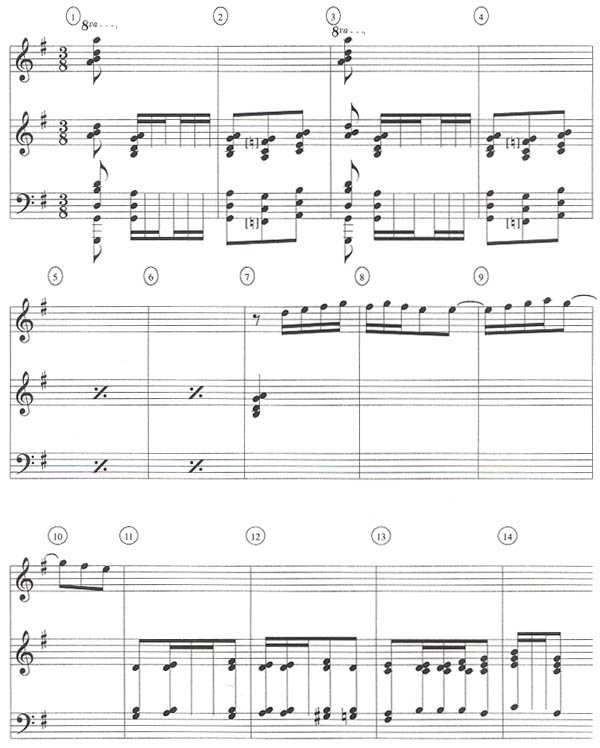
But Debussy was still uncertain how to continue the theme; having written out the introductory chords and the first four bars of the tune in ink, he added the next four bars of accompaniment without any tune. Unsatisfied, he tried again. This time he rewrote the truncated theme at the end of the second system in pencil, adding chords to mm. 10-11 in pencil, and a new version of mm. 12-13 in ink (see Figure 5b). As it happens, the chromaticisms of the accompaniment for mm. 10-11 prefigure those found in m. 20ff. of the finished score.
Figure 5b. Par les rues et les chemins, F-Pn Ms. 21005, fol. 4r.
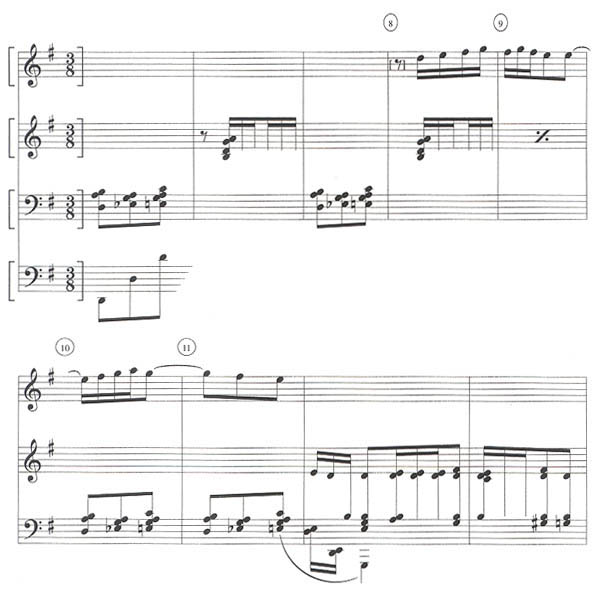
Despite the large number of preliminary workings for Par les rues et les chemins, there are no examples of the complete sevillana theme in the Images sketchbook or in F-Pn Ms. 21005; the only manuscript source that contains the sevillana theme in its entirety is F-Pn Ms. 10931, an intermediate draft for the reprise and the coda. As shown in Figure 7, fol. 2r contains a single statement of the complete tune, with its rising fourth pickup, the triplet turn, the sequence on E and the stepwise descent back from D to G. Significantly, this statement leads directly to two rhythmic variants of the  major theme on G and F.
major theme on G and F.
From the preceding discussion it seems that when Debussy began to compose Parles rues et les chemins, he had only a very general idea of writing a sevillana. He translated this idea into a primitive theme and accompaniment that also included the  major theme. Later, he decided to separate these two gestures, using the former for the opening A section and the latter for the B section. There is an obvious reason for these changes. Once Debussy started working out the sevillana and
major theme. Later, he decided to separate these two gestures, using the former for the opening A section and the latter for the B section. There is an obvious reason for these changes. Once Debussy started working out the sevillana and  major themes, he became aware of their different formal possibilities; he must have realized that the sevillana theme had great potential for transformation and hence would be better suited for the long outer sections, while the
major themes, he became aware of their different formal possibilities; he must have realized that the sevillana theme had great potential for transformation and hence would be better suited for the long outer sections, while the major theme could be used in a narrower context as an ostinato to the B section. It was only on reaching the reprise and coda that he could unite both themes, thereby satisfying his first intuitions. In other words, Debussy decided to differentiate between the two themes when he became aware of their formal implications and shifted his attention from bottom-up to top-down concerns.
major theme could be used in a narrower context as an ostinato to the B section. It was only on reaching the reprise and coda that he could unite both themes, thereby satisfying his first intuitions. In other words, Debussy decided to differentiate between the two themes when he became aware of their formal implications and shifted his attention from bottom-up to top-down concerns.
The final examples suggest one spot in which the reverse process is true, namely where Debussy changed his large-scale plans for local reasons. The earliest workings for the reprise appear on fol. 11r of F-Pn Ms. 21005. Though fragmentary, these jottings suggest that Debussy decided fairly early on to bring back the truncated sevillana theme in the tonic G major. Since Debussy sketched the chordal motive in  major, one may infer that he also intended to recall the key of the contrasting B section. Once again, this practice has clear precedents in the Prélude à L'Après-midi d'un faune, Nuages, and Fêtes.
major, one may infer that he also intended to recall the key of the contrasting B section. Once again, this practice has clear precedents in the Prélude à L'Après-midi d'un faune, Nuages, and Fêtes.
Debussy's next workings for the reprise appear in F-Pn Ms. 10931 (Figure 6). On fol. 1r, one finds a deleted version of what will become mm. 290-312. Although this sketch is extremely brief it shows how Debussy initially connected the sevillana theme to the chordal figure. The first system begins with a chromatic descent G- -F-D-
-F-D- -
- in the bass, followed by four bars of the chordal figure in
in the bass, followed by four bars of the chordal figure in  major (marked by Debussy with a bracket). The second system then contains material that was destined to appear in mm. 300-312 of the final score. Debussy gives two truncated statements of the sevillana theme—the first on
major (marked by Debussy with a bracket). The second system then contains material that was destined to appear in mm. 300-312 of the final score. Debussy gives two truncated statements of the sevillana theme—the first on  , the second on D. These themes are separated by four bars of the chordal figure from the top system, which Debussy indicated with the numbers "1 2 3 4."
, the second on D. These themes are separated by four bars of the chordal figure from the top system, which Debussy indicated with the numbers "1 2 3 4."
Figure 6. Debussy, Par les rues et les chemins, F-Pn Ms. 10931, fol. 1r.
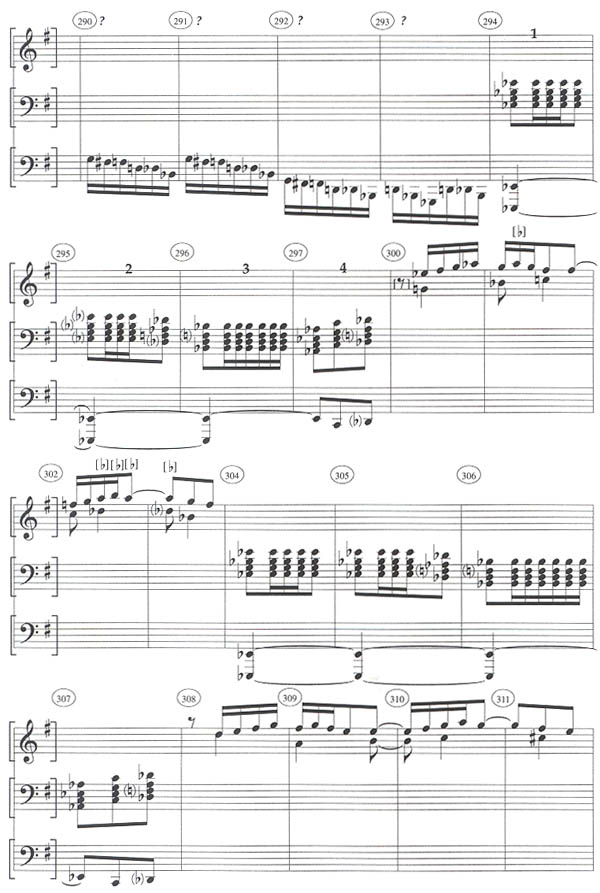
With the general scheme of the reprise mapped out, Debussy reworked the entire ending on fol. 2r-1v (Figure 7). This new version has several important changes. For one thing, instead of using the chromatic bass motive to connect the truncated sevillana theme to the chordal figure, he now included the complete sevillana theme along with two statements of the B theme, one starting on G, the other on F (mm. 286-92). For another, he excised the first  major statement of the sevilliana theme and the second version of the chordal figure, and left a single truncated presentation of the sevillana theme on D. Finally, Debussy added an almost complete version of the coda (mm. 317-34) along with its chromatic inner parts (mm. 317-29).
major statement of the sevilliana theme and the second version of the chordal figure, and left a single truncated presentation of the sevillana theme on D. Finally, Debussy added an almost complete version of the coda (mm. 317-34) along with its chromatic inner parts (mm. 317-29).
Figure 7. Debussy, Par les rues et les chemins, F-Pn Ms. 10931, fol. 2r-1v.
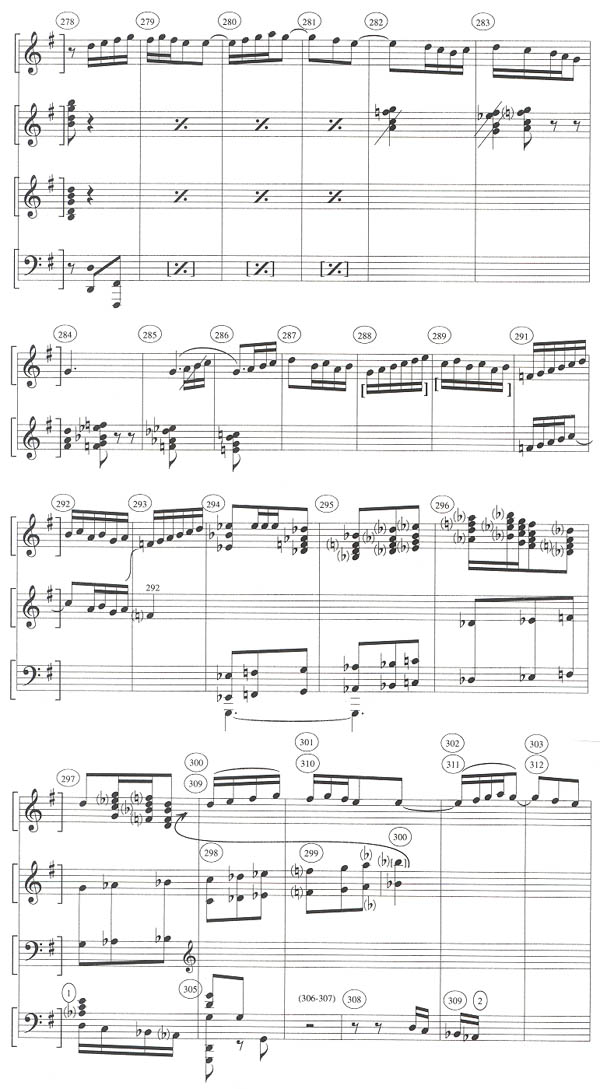
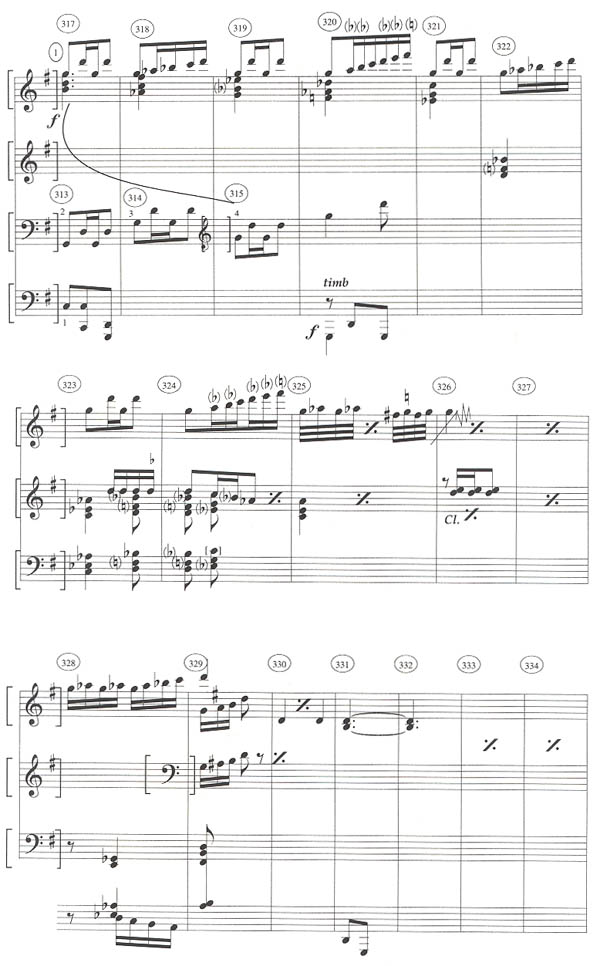
Still unhappy, Debussy revised his score again. This is apparent from the various added staves, arrows, and numbers given in Figure 7. First, we see that he altered the melody in mm. 290-291 and added the bass part in mm. 294-300. Second, he repeated the truncated sevillana theme on D (mm. 300-303, and 309-12) and inserted two early versions of the phrygian cadence (mm. 304-9). Third, he revized the beginning and the ending of the coda: he copied out the start of the coda (mm. 313-15) and the bass part for m. 317ff. Now, the only bars missing from the final version are mm. 306-7 and m. 316. At this same time, or at some later date, Debussy included the chromatic inner parts of the reprise; from the corrections it seems that he had difficulty deciding which notes to use.
Figures 6 and 7 suggest that when Debussy started to write the reprise, he was not entirely sure how the piece was going to end. He knew it would progress chromatically from the sevillana theme in G major to the chordal figure in  major, but was unclear about how to do so; he had not decided to recycle the B theme, or to add the chromatic inner parts. Debussy apparently came up with his final solution when composing the coda; he then went back and reworked the reprise along the same lines. In other words, he ended up working from back to front. Once again, it illustrates the fluid way in which he considered both local and global concerns.
major, but was unclear about how to do so; he had not decided to recycle the B theme, or to add the chromatic inner parts. Debussy apparently came up with his final solution when composing the coda; he then went back and reworked the reprise along the same lines. In other words, he ended up working from back to front. Once again, it illustrates the fluid way in which he considered both local and global concerns.
This discussion began by noting that in order to understand the way in which composers write music, one must not simply focus on historical and theoretical aspects of the work, but must also draw on general notions of music cognition. In his book, The Society of Mind, Marvin Minsky notes: "Surely it is premature to ask how great composers write great symphonies before we know how ordinary people think of ordinary tunes." He adds, "I don't believe there is much difference between "normal" and "creative" thought. Right now, if asked which seems more mysterious, I'd have to say the ordinary kind."25 In fact, since ordinary people do not usually bequeath us large bodies of written revisions, it may well be the case that studying the compositional processes of great composers may shed considerable light on the ways ordinary people think of ordinary tunes. Although they cannot be interpreted in isolation and represent only one type of evidence, composers' working processes provide an important key to unlocking the mysteries of the human mind.
1John Sloboda, The Musical Mind: The Cognitive Psychology of Music (Oxford: Oxford University Press, 1985), 102. This paper was originally presented at Music Theory Midwest May, 1992. I would like to thank Jennifer Williams Brown for many helpful suggestions, and Robin Lehman for permission to publish transcriptions of the Images sketchbook.
2Sloboda, The Musical Mind, 118.
3Sloboda, The Musical Mind, 104-23.
4See Lewis Lockwood, "On Beethoven's Sketches and Autographs: Some Problems of Definition and Interpretation," Acta Musicologia 42 (1970): 32-47.
5See Nelson Goodman and Catherine Z. Elgin, Reconceptions in Philosophy and Other Arts and Sciences (Indianapolis: Hackett, 1988), 55.
6Leonard B. Meyer, Style and Music: Theory, History, and Ideology, Studies in the Criticism and Theory of Music (Philadelphia: University of Pennsylvania Press, 1989), 94.
7As cultural psychologist Roy D'Andrade explains: "Cultural models are actually little machines. They are software programs, not just data. Of course, the brain contains a more general mental machine that runs these little cultural machines, just as there is a more general program that runs a specific Fortran program. But the little programs are important, because without them the general program, which does various universal procedures such as search, chunk, store, and recall, would have to work very hard to do very little." Roy G. D'Andrade, "Cultural Cognition," in Michael Posner ed., Foundations of Cognitive Science (Cambridge: MIT Press, 1989), 824.
8Leonard B. Meyer, Explaining Music (Chicago: University of Chicago Press, 1973), 23-24.
9Sloboda, The Musical Mind, 103.
10Alvin Goldman, Epistemology and Cognition (Cambridge: Harvard University Press, 1986), 235.
11Sloboda, The Musical Mind, 103.
12For further details, see Robert Gjerdingen, The Classic Turn of Phrase: Music and the Psychology of Convention (Philadelphia: University of Pennsylvania Press, 1988), 23.
13For a more extensive discussion of these ideas, see Matthew Brown and Douglas J. Dempster, "The Scientific Image of Music Theory," Journal of Music Theory 33 (1989): 65-106 and Matthew Brown, "A Rational Reconstruction of Schenkerian Theory," (Ph. D. diss., Cornell University, 1989).
14For a more extensive discussion of these topics, see my forthcoming book, Debussy's Ibéria (Oxford: Oxford University Press).
15For a discussion of the formal structure of the Prélude, see Matthew Brown, "Tonality and Form in Debussy's Prélude à l'Après-midi d'un faune," Music Theory Spectrum 15 (1993): 127-43.
16Significantly, Manuel de Falla specifically referred to Par les rues et les chemins as a sevillana; see Manuel de Falla, "Claude Debussy and Spain," in David Urman and J. M. Thomson trans., Manuel de Falla.: On Music and Musicians (London: Marion Boyers, 1979), 44.
17Richard Parks, The Music of Claude Debussy (New Haven: Yale University Press, 1989), 4.
18See François Lesure, Catalogue de l'oeuvre de Claude Debussy (Geneva: Minkoff, 1977), 126-27 and James R. Briscoe, Claude Debussy: A Guide to Research (N.Y.: Garland, 1990), 31-2.
19See Jacques Durand ed., Lettres de Claude Debussy à son éditeur (Paris: Durand, 1927), 27-28.
20According to Durand and Vallas, Rondes de printemps is unrelated to Valse—see Durand, Lettres à son éditeur, 28 and Léon Vallas, Claude Debussy: Life and Works, trans. Maire and Grace O'Brien (London: Oxford University Press, 1933), 164. Concerning Debussy's decision to score the set, see François Lesure and Roger Nichols ed. and trans., Debussy Letters (Cambridge: Harvard University Press, 1987), 168-69, and Durand, Lettres à son éditeur, 45-46.
21The orchestral draft for Ibéria is dated "25-XII-1908." Various letters suggest that Debussy prepared the autograph in the spring of 1909 (e.g., Durand, Lettres à son éditeur, 68-69).
22Pierné conducted the premiere of Ibéria on 20 February 1910 at the Concerts Colonne. For a brief description of the corrected score, see Denis Herlin, Collection musicale François Lang, Abbaye de Royaumont (Paris: Klincksieck, 1993), p. 53.
23Debussy made no secret of the fact that he took a long time to write most of his pieces. In an interview for Le Figaro (14 February, 1909), he confided: "It took me twelve years to write Pelléas et Mélisande, so you see I don't write quickly. One always writes too much and thinks too little." François Lesure and Richard Langham Smith ed. and trans., Debussy on Music (New York: Knopf, 1977), 239. As for his habit of improvising, Marguerite Vasnier recalled, "He would improvise for a long time and then walk up and down the room humming, either with a cigarette in his mouth or rolling one in preparation. Then, when he was sure, he wrote. He made few corrections but he spent a long time getting it right in his head or at the piano before writing. He was not easily satisfied with his work." Marguerite Vasnier, "Debussy à dix-huit ans," Revue de Musicologie 7 (1926): 17, translated in Roger Nichols ed., Debussy Remembered (London: Faber, 1992), 18.
24See Durand, Lettres à son éditeur, 57-8; Lesure and Nichols, Debussy Letters, 188.
25Marvin Minsky, The Society of Mind, (New York: Simon and Schuster, 1986), 80.
